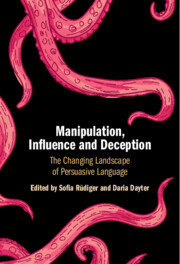Book contents
- Manipulation, Influence and Deception
- Manipulation, Influence and Deception
- Copyright page
- Contents
- Figures
- Tables
- Contributors
- I (Re)framing Persuasion
- 1 Persuasion and Influence in Linguistic Research
- 2 Persuasion, Manipulation, Seduction
- II Persuasion and (New) Contexts of Use
- III The Dark Side of Persuasion
- IV Persuasion and Algorithms
- V Discussion
- Index
- References
2 - Persuasion, Manipulation, Seduction
Through a Pragmatic Lens
from I - (Re)framing Persuasion
Published online by Cambridge University Press: 10 June 2025
- Manipulation, Influence and Deception
- Manipulation, Influence and Deception
- Copyright page
- Contents
- Figures
- Tables
- Contributors
- I (Re)framing Persuasion
- 1 Persuasion and Influence in Linguistic Research
- 2 Persuasion, Manipulation, Seduction
- II Persuasion and (New) Contexts of Use
- III The Dark Side of Persuasion
- IV Persuasion and Algorithms
- V Discussion
- Index
- References
Summary
In this chapter I argue that seduction is what makes it harder to tell the difference between persuasion – which cannot do away with seductive language in order to win over the other – and manipulation which plays on the addressee’s emotions or emotional needs (Baron, 2003). Seduction thus constitutes the weak spot of persuasive discourse through which manipulative tricks can penetrate. Manipulation is commonly defined as what can only be covert and is null and void if discovered; I will prove that this is not necessarily the case, especially when the addressee can perceive manipulation but is seduced by it anyway. What distinguishes persuasion from manipulation is the strength of the pressure put on the Hearer to acquiesce (Sorlin, 2017a). The role of seductive discourse as defined in this chapter is precisely to attenuate this pressure (on the surface) by using different linguistic, cognitive and pragmatic means that are detailed here and illustrated with an example drawn from the political TV series House of Cards (Netflix 2013—2018). My goal is to show that there is such a thing as a pragmatics of seduction, predicated on strategies of influence in precarious balance between persuasion and manipulation.
Keywords
Information
- Type
- Chapter
- Information
- Manipulation, Influence and DeceptionThe Changing Landscape of Persuasive Language, pp. 19 - 42Publisher: Cambridge University PressPrint publication year: 2025
References
Accessibility standard: Inaccessible, or known limited accessibility
Why this information is here
This section outlines the accessibility features of this content - including support for screen readers, full keyboard navigation and high-contrast display options. This may not be relevant for you.Accessibility Information
Content Navigation
Allows you to navigate directly to chapters, sections, or non‐text items through a linked table of contents, reducing the need for extensive scrolling.
Provides an interactive index, letting you go straight to where a term or subject appears in the text without manual searching.
Reading Order & Textual Equivalents
You will encounter all content (including footnotes, captions, etc.) in a clear, sequential flow, making it easier to follow with assistive tools like screen readers.
Visual Accessibility
You will still understand key ideas or prompts without relying solely on colour, which is especially helpful if you have colour vision deficiencies.
You benefit from high‐contrast text, which improves legibility if you have low vision or if you are reading in less‐than‐ideal lighting conditions.
